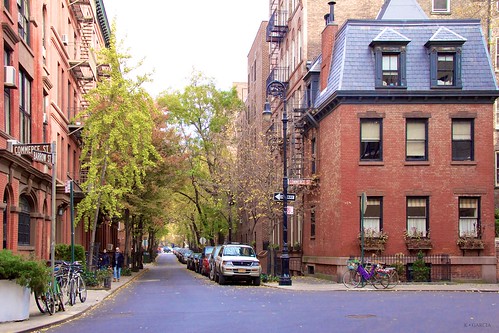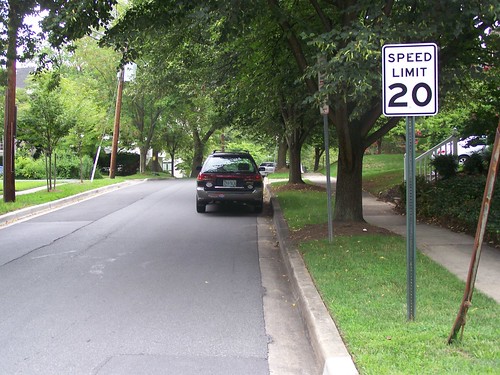Quote of the day: why vehicular cycling doesn't work
There was a post the other day at GGW on vehicular cycling, "We can make our roads a lot more bike friendly, here's how." It discusses the difference between the vehicular cycling approach, which calls for cyclists to learn how to ride in motor vehicle traffic, and to be treated just like cars versus an approach that aims to reduce cyclist stress associated with mixing in traffic.
-- Low-Stress Bicycling and Network Connectivity, Mineta Transportation Institute
-- "Portland's Bicycle Brilliance," The Tyee. This article discusses the approach laid out by Roger Geller of the Portland Dept. of Transportation. His research found that 10% of people will bike in the kind of environment provided today, but 57% more people would bike, if they didn't have to ride in high speed mixed traffic.
In an e-conversation a few years ago, sparked by this article, "Britons unmoved by pro-cycling campaigns: Most regard bicycles not as legitimate form of transport but as children's toys or preserve of hobbyists, research finds" in the Guardian, Anne Lusk, a researcher at the Harvard School of Public Health, made the comment that it is no surprise that the two countries that have adopted the vehicular cycling approach, the US and the UK, have the lowest take up of cycling as transportation.

Barrow Street Corner, West Village, Manhattan. Flickr photo by Kenneth Garcia.
And it should be no surprise that where biking is experiencing a resurgence, it happens to be in center cities, usually in those areas with urban design characteristics dating to the Walking City (1800-1890) and Streetcar/Transit City (1890-1920) eras (paper by Peter Muller), when streets were built more narrowly, and where the built environment is more balanced between people and buildings, which works to slow down motor vehicle speeds.
Caption: A bicycle boulevard on Milvia Street in Berkeley. From "Berkeley plans to increase city bike friendly initiatives," Daily Californian.
I argue that the neighborhood/local streets in such places, for the most part already function as bicycle boulevards, without having to create much in the way of special infrastructure.
And as biking becomes more of an accepted practice--just as it took 50 years to change accepted attitudes concerning living in cities as a reasonable choice--more people are riding in the places that are most conducive.
In the GGW thread, commenter Jonathan Krall hit the nail on the head about why vehicular cycling doesn't work--people motor vehicle operators already treat each other horridly, and cyclists can't afford to be treated so equally when a car is 2000 to 3000 pounds heavier and up to four times faster.
JK writes:
As for being treated like a vehicle, no thanks. Long hours of riding have shown me how car drivers treat each other. Many cyclist complaints--passing too closely, tailgating, honking, yelling--are exactly what drivers do to each other. Forrester was wrong. People on bicycles fare best when they are recognized as human beings who deserved extra care and not just "drivers of vehicles."

20 mph speed limit sign on Stanford Ave. at East Ave in the Town of Chevy Chase, Maryland
Labels: bicycle and pedestrian planning, car culture and automobility, traffic engineering, traffic safety and enforcement, urban design/placemaking




9 Comments:
its about time that saner heads are prevailing on GGW- which has been a hotbed of vehicular cycling enthusiasm and activism- I was literally hounded off of that miserable site years ago by none other than Alpert himself- who made fun of my inclusive cycling comments and told me how wrong I was. What an arrogant *&$#* he is. Amazing how things change- and how vehement these people can be until enough other people start chiming in to back up rational concepts. On the other hand- your site Richard was always a steadfast place and space for reason and consideration.
GGW reader for years and I never picked up on any vehicular cyclist bent.
sounds like more trolling to me
Vehicular cycling seems to work fine when:
1) As you said, the road conditions predate 1940.
2) there isn't much car traffic
3) Road conditions are good (in terms of the surface quality).
I'd agree that in DC we mostly have the first. In large chunks of the city, especially at certain times, there is very little auto traffic. Road quality is poor to awful almost everywhere.
But as soon as you start mixing traffic up -- and Im not sure where that point is -- bikes are not going to do well.
As usual I think you need a more granular approach. Take an area (say georgetown, or U st, or wherever) and figure out how to make the area more bike friendly, rather than throw down a bike lane and think that will slow traffic down.
Gee, I try to think more granularly too. That's the problem. Most people generalize, and they have a very simplistic approach to begin with.
That ends up being the crux of my "problem" with the average entry at GGW.
One of the things I argued when I was in Balt. County, but at the "meta" level, is that the next direction for bike and ped planning should be (1) integration of programming with infrastructure (Arlington does a wee bit of this) and (2) creation of sub-city/district plans that also integrate planning, infrastructure, and programming.
(I used to think Toole Design and Alta were uniformly great, but now that I know even more I see lots of gaps in the bike and ped master plans they produce.)
More and more, in some other contexts, I am fervently convinced that you have to lay the frameworks down, and concomitantly, develop the master set of "measures" that can be appropriately applied.
When I wax about the 2006 era ArCo Master Transportation Plan, it's because each of the elements is internally consistent and also derives from the Goals and Objectives element, which with each element is also internally consistent.
E.g., I am trying to get a GGW commenter to do a map for/with me, and in deciding what to include and not to include on specific iterations, it comes down to scale (multistate, regional, metropolitan, suburban, center city) and primary, secondary and tertiary subnetwork.
Or my inter-city vs. intra-city transit service/networks.
It's why previous GGW fantasy maps showing rail get bollixed up when they include VRE etc. and the H St. streetcar. The latter is intracity and short trip oriented, and is focused on a completely different scale of service. That they are both "rail-based" isn't really the issue, despite what people think.
But that's nuance or granularity.
In terms of biking, while I have since extended the model (which M1EK of Austin on a GGW thread seemed to get bent out of shape on, in his argument against cycletracks) from the 6 scales I laid out in doing the Baltimore County plan, I argue we need to plan at 8-10 scales:
- 1 mile radius from transit centers and schools (but this should include libraries and parks)
- 3 mile radius from town centers (that's for a county, for a city it would be smaller, maybe)
- 3 to 9 mile distance along corridors, connecting town centers along the way
- perpindicular connections between corridors depending on whether they are N-S or E-W
- creating a countywide (or citywide) bikeways/shared use path network
- ensuring connections between jurisdictions
Now I would add
- interconnecting and extending with a metropolitan scale bikeways/shared use path network
- rural biking (where usually the measure = "wide shoulders", which you see a lot in Maryland).
The kinds of factors that MoCo used in creating their "heat map" jibes with this--denser areas with a traditional grid street network have a lot more opportunity to capture bike trips than a typical suburbanized area with a disconnected road network.
Now the big thing in the "trade" seems to be "level of stress." I haven't kept up. And I haven't yet read any of the key papers, like the one I cited from the Mineta Institute.
Sure, it's important, but I think if you structure consideration along the lines that I did, you get at the same point.
In our back and forth interactions on the map project, I was thinking about the framework I was laying out, which is relevant to biking in the same way. I was thinking, if he agrees to do the transit maps, later we could do biking ones also.
Not so much walking, because walking is short trip oriented. But within a city, you could do it similarly, I suppose.
The biggest single problem in DC cycling as I see it is that the planners or DCDOT are avoiding placing any kind of real cycling infrastructure on the major roads such as Independence or Constitution Avenues,lower 14th street, Connecticut or Wisconsin, or NY Avenue. basically this shows them up for what they really are- total and complete wussies about doing anything that might rock the boat in terms of aggravating Nortern Viagaran suburban Car centric a-holes or Ward 9 -er's who use these roads as major com-mutant highways. These planners in DC need to get it together and stop this crap and put in real separated protected bikeways on these major arteries - steal back for us a few lanes from the car driving public- and stop the nonsense or we will NEVER get real numbers of cyclists to increase. Especially for women cyclists and others who are not maniac vehicular cycling fascists .These roads are super dangerous to use a bicycle on and anyone who does bike on them is taking their lives right onto the edge.
http://199.192.26.113
lofu88
lofu 88
http://rumustogelsgp.online/
lofu88
lofu 88
rumus togel sgp
rumus togel sgp online
Post a Comment
<< Home